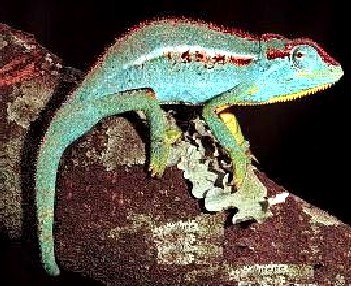 Family: Chamaeleonidae
Family: Chamaeleonidae
Common Name: Elliot's Chameleon
Scientific Name: Trioceros ellioti
Food: Insects
Distribution: Burundi, Kenya, S Sudan, Rwanda, Tanzania, Uganda, N/E Zaire (Democratic Republic of the Congo)
Habitat:
Color Discription: gray, brown, blue, black and green but at different times and in different populations the coloration (especially males) may include bright markings similar to those of Trioceros lateralis. A dark gular spot or slash is often present and a light lateral stripe is often present.
Physical Discription: The flattened head lacks occipital lobes but small, elevated parietal crests are present and covered by enlarged, granular scales. Low crests are present in the gular, abdominal and vertebral surfaces. Because of the wide range of habitats and many subpopulations of this species. Males are slightly smaller and typically exhibit brighter coloration but are most reliably identified on the basis of a prominent hemipenal bulge.
Size: Females 9" and the males are smaller
Temperatures/Humidity: Temperatures should not exceed 85F during the day and a drop to 60F at night is highly desirable. Humidity should be maintained at a minimum of 80%. While they cannot tolerate excessive heat. They enjoy basking in the sun.
Breeding/Reproduction: Depending on the size, and maturity, they bear 2 - 18 live young. Gestation is approximately 90 - 160 days and females may give birth up to 4 times a year. Females may be receptive 14 days after giving birth and are capable of retaining sperm. Copulation is performed with little fuss or aggression. Babies are a little over 1" long at birth and are extremely fragile. Drosophila melanogaster and two day old pinhead crickets are appropriate sized insect prey, with some hatchlings eating springtails. Hatchlings should be misted with a very fine, warm mist; care should be taken to avoid eye damage and aspiration of water. Maturity is reached in 6 - 9 months.
Cage Setup: Requires well lighted and well ventilated individual screen cages. Despite their small size they are highly aggressive toward each other and individual housing is a necessity. Long term success in maintaining this species has yet to be achieved.
Water: Water can be provided by simulating warm rainfall (Misting) and a drip system.
Special Needs:
Special Note: This species is prone to mouth and sinus infections so great care must be taken in watching for symptoms.
They should be kept only by "expert" keepers only.